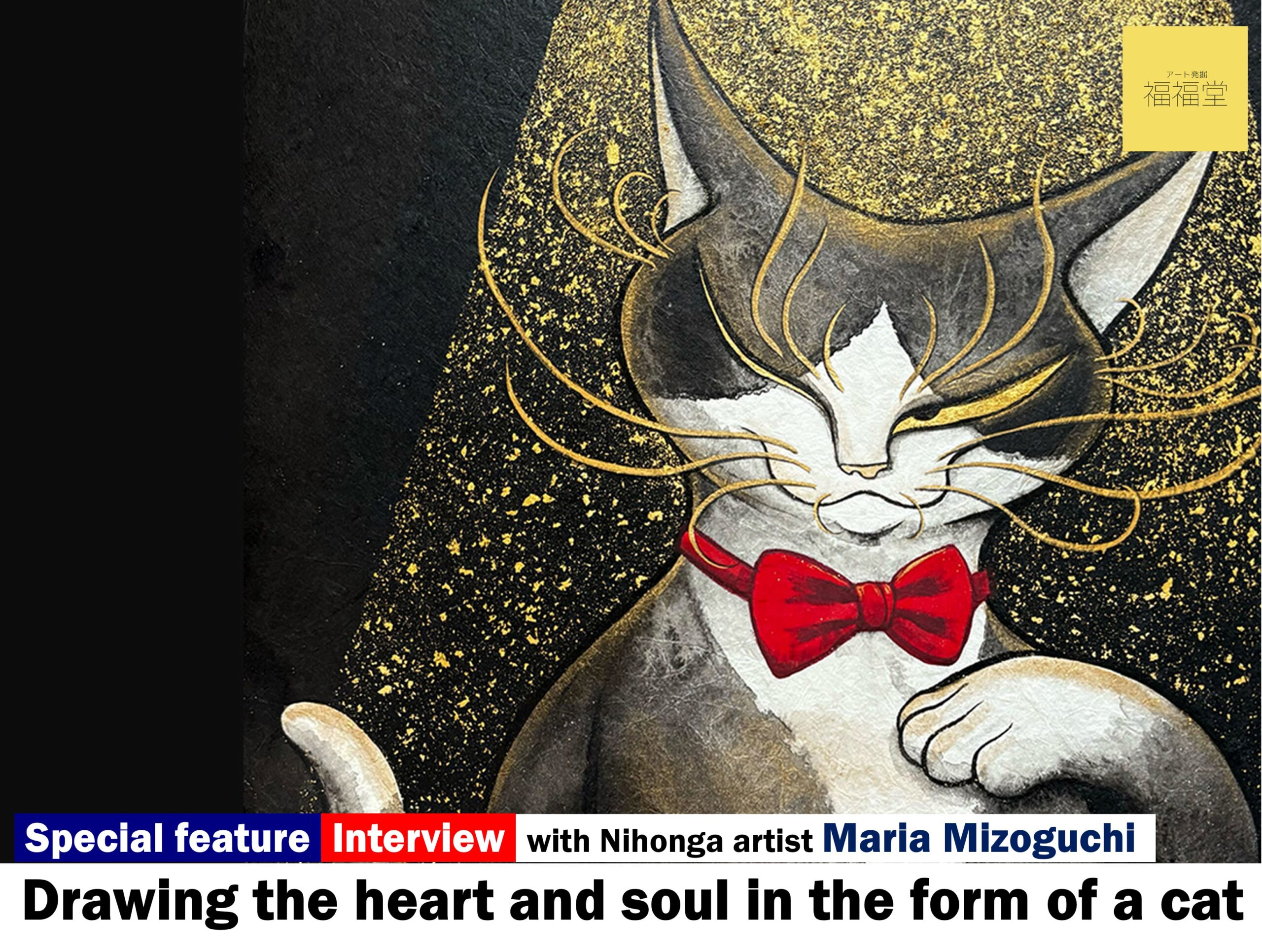
Interview with the Nihonga artist, Maria Mizoguchi. Please enjoy!
Interview with Nihonga artist Maria Mizoguchi
Growing up, spending countless hours making art and playing with animals
What were you like as a little girl?
I was a very active child, always finding places to run around in, and literally running in the nearby parks every day from morning to evening. From a young age, before going to preschool, I loved making snails out of cardboards or drawing pictures. I think I was two or three years old at the time. I’d always enjoyed having a creative outlet as a young child.
Oh! You were quite busy even before preschool! When did you start drawing?
There was a local drawing class I used to go to, and I filled up an entire sketchbook in the first class. It was my first time holding a brush, and I just started painting, filling up tens of pages until the last page. I’m told that I continued to use up an entire sketchbook at each class.
Once I started drawing, my focus would continue for hours. I arrived at the atelier early and drew for hours on end until everyone left, earning me the nickname “Leonardo Maria”.
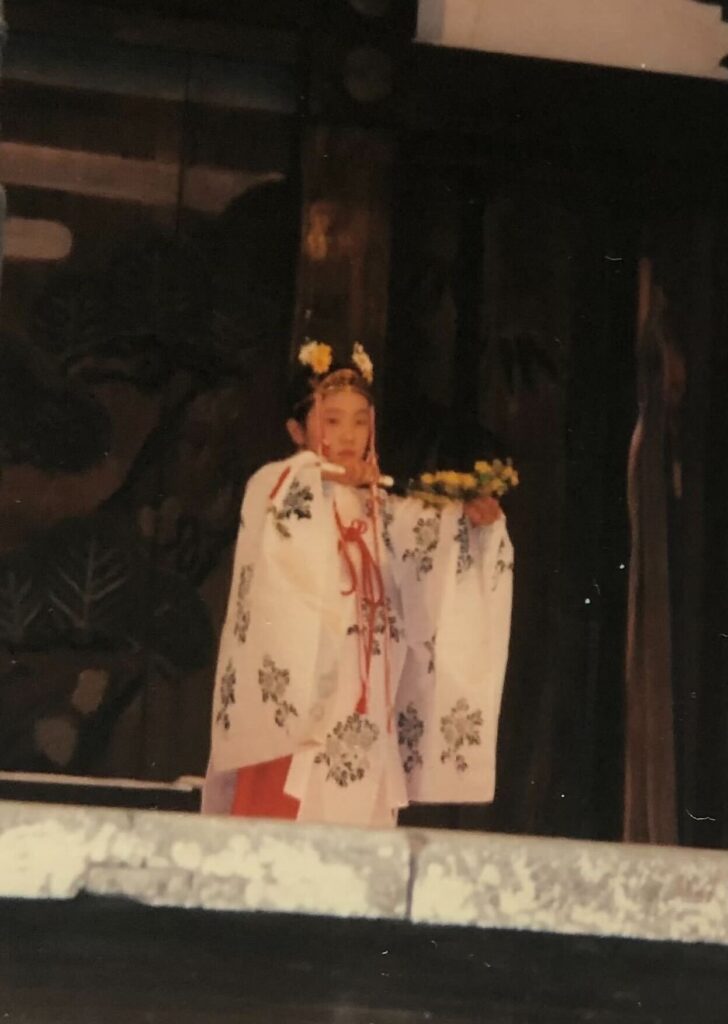
That may have been an indication of your gift as an artist at such an early age. Were you exploring any other creative outlets other than drawing?
I’d been trying out a variety of programs as a young child. My parents encouraged me to try a smorgasbord of activities, saying “she’ll never know until she tries it”. Starting with drawing, there was swimming, piano, English conversation, and Kumon on top of weekly Girl Scout activities. I continue to be incredibly grateful for the opportunity my parents gave me to experience a wide variety of things.
Entering elementary school, I joined the baton team since I thought the twirling batons looked amazingly cool.
I became interested in Kyokushin Karate later on, and continued throughout middle and high school until being made captain, at which point the responsibilities took up so much time that I quit karate altogether.
I had no idea of your martial arts history! Does this mean that you’re quite strong?
I doubt it. I also dabbled in seasonal activities, such as performing maiden dance at a Shinto shrine and learning the art of Japanese tea ceremony. I didn’t get too into the etiquette side of things, but was told I could make a decent cup of tea ? that the foam and sweetness were in balance.
My tea ceremony experience was quite the opposite, my foams dissolved into gaps and I was horrible at it!
There are some things that are helpful to know, such as having a slight slant and the positioning of the whisk makes a difference in the outcome. At first, it should feel like you’re loosening the Matcha powder, but the tea whisk should be floating at the end to avoid the whisk tips from breaking.
I’m guessing that you’re very dexterous. Yet, you previously mentioned that you didn’t know how to tie a bow and now I’m more curious about your dexterity.
I’m not very dexterous. My clumsiness meant that I had to put in much more effort to learn. Persistence has been one of my virtues since I was young, including when I was learning to draw.
There have been many detours along the way, but of all the programs I’ve attended, I think the one that had the biggest influence on me was the drawing class.
Did you decide you wanted to become a painter around that time?
I was in fourth grade when I made the decision. I just loved to paint and draw.
Was it around the same time that you understood that you had a certain bond with cats and other animals, which ultimately became your signature motif?
My family already had a pair of mini-rabbits two weeks before I was born. I was surrounded by animals as an infant, and thus was naturally drawn to animals from an early age.
There were three types of hamsters at home; Djungarian, King, and White-snow hamsters. We also took care of silkie chickens (Ukokkei); they were sweet, smart and wonderful to have. I also kept insects like roly-polies, bell crickets, rhinoceros beetles, stag beetles, and sometimes even hatched cicada larvae into adults.
We also looked after Dojo loaches, and of course a dog (a Shih Tzu). In addition, there were two amphibians, the Japanese lizard and the Kana-hebi (Japanese grass lizard).
Japanese grass lizard (Nihon Kana-hebi)??
The Nihon Kana-hebi has the word ‘snake’ in its name but it’s actually a lizard, very cute and friendly, and will climb onto your palm.
Meeting the Futebuteshii cat
Was the origin of the “Cat” (featured in your art), one of your former pets?
In the beginning, I didn’t particularly like cats. I only started becoming drawn to cats once we had one come stay with us. Cats really grow on you, and it changed everything for me.
Our first cat came to us when I was in seventh grade. He was a cross between an American Shorthair and a Japanese breed. He lived a long life; he was 15 when he passed. Despite his longevity, he was a bit of an oddball… I’m not sure how to put it except to describe him as having a quirky personality, and thus became my muse for the oft featured “Hinekure Neko” (Sourpuss).
So, he was the inspiration!
I can honestly say that I wouldn’t be here today if it weren’t for him. He was handsome and wasn’t shy about going up to humans and unabashedly doing things to them that people don’t like being done to.
Do you still have a picture of him?
Yes, I do.
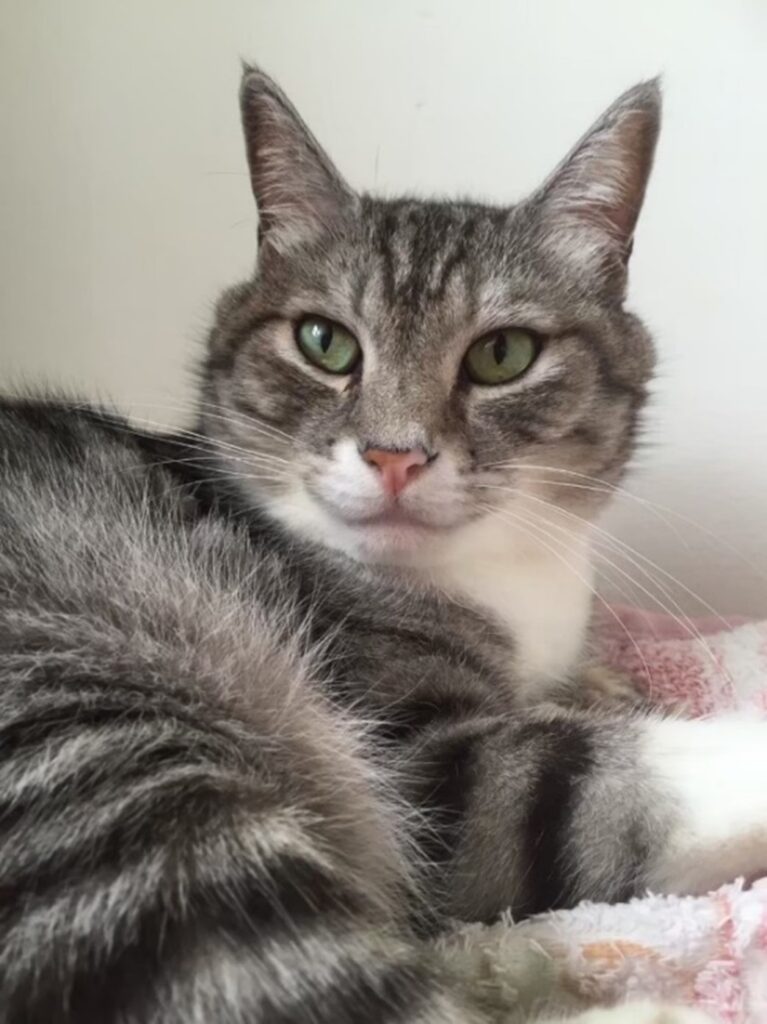
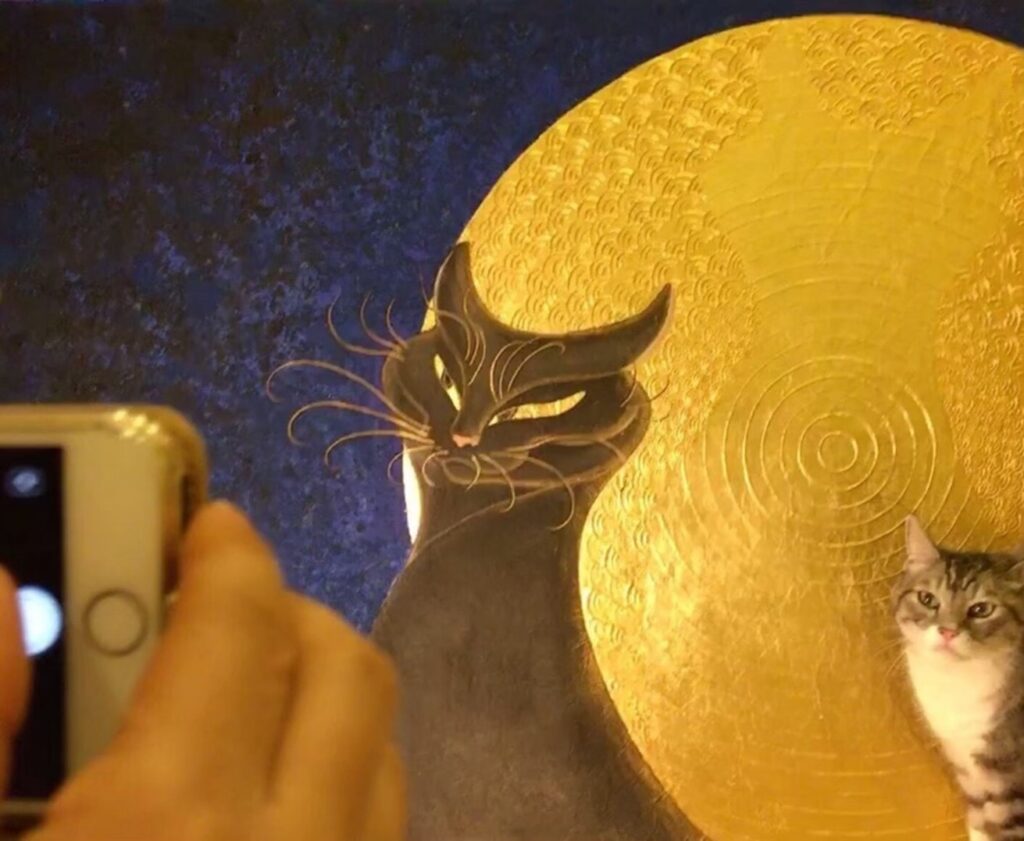
He’s magnificent and yet grumpy looking.
He was gorgeous, and he seemed to know it too. Whenever I started sketching him, he would strike a pose in a certain angle that enhanced his beauty. You could practically hear his modeling voice ordering me “Wait, let me get my angle right”, then “Got it! Go on, start sketching!”.
That’s fascinating.
He loved being photographed and having me sketch him. Of equal interest is that he was skilled at jumping right on top of the page of the book I’d opened to read, or he would rip the newspaper that I’d just spread out. Yet, he had remarkably good manners during mealtime, and was always mindful when I was drawing. He never disturbed me, nor jumped onto my paintings. It was almost as if he knew that’s where the boundaries lay.
What a well-behaved cat, perhaps he could sense it.
I believe so. If I were busy drawing when he came into the room, he would slip out as soon as I told him “I’m too busy drawing at the moment”, almost as if he could understand me.
He could’ve been an artist in his prior life, he knows what’s fine and what isn’t.
He was wonderful and extraordinary. I thought he’d live till 30, seeing as he was good with people as well.
Do you still draw sketches of him?
I do, he’s still my muse. I called him Ryu-chan, spelled “Ryu” in Katakana, hoping that he’d be strong like a dragon (Ryu being the Japanese word for dragon). I gave him the name when I was in middle school, and he lived up to his name.
He was still a kitten when he came to us. In hindsight, he had a big personality and was tenacious, but we loved him like no other, telling him we loved him every single day, and how he was the most gorgeous cat in the world.
How he matured into a cat with such an extreme strong sense of self, I don’t know.
High school aspirations to become a Nihonga artist
After the cat came into your life in middle school, how was your high school life? What kind of drawings did you do?
I attended a small girls’ high school, and was able to spend time concentrating on my interests, such as being captain of the art club. At the time, I was trying out pointillism, using extremely fine point head pens (0.05mm) by Pilot. Some of my art pieces were as large as 20F size (73 x 61cm). I started with very fine lines but gradually moved onto pointillism, using only black and white.
That’s hard to imagine, seeing your paintings now.
In those days, my drawings used to be something in between realism and abstract. My style was a lot more realistic then.
I hear you won quite a lot of awards as a student. Did the award-winning pieces use this type of style you just described?
Yes, those pieces used that type of semi-realism and abstract style. My high school teacher was instrumental in helping me apply to a number of public exhibitions.
Is there a particular piece of work from that era that’s meaningful to you?
During my freshman year at high school, I made a drawing of shrikes and cuckoos, titled “Musho no Ai” (Selfless Love). I remember it so well, having won an award for it and went on to be exhibited at the Setagaya Art Museum.
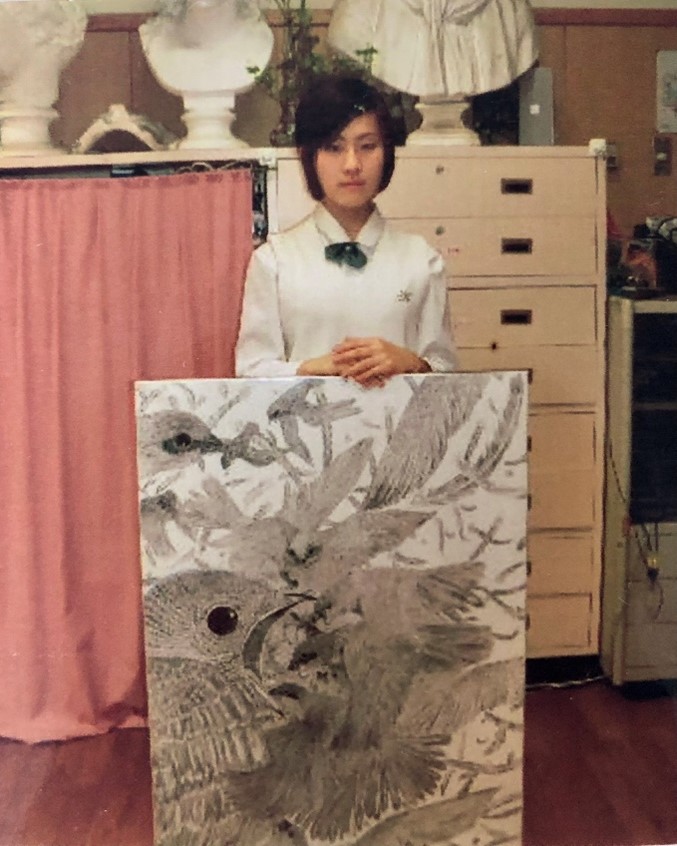

“Musho no Ai” (Selfless Love) at the high school art club
Were you taking fine art concentrations in high school?
I took regular high school classes, but for electives, I chose mostly art related courses. School art club teachers and advisors helped me to study and apply to various Colleges of Arts. In the summer, a teacher who had graduated from the Musashino Art University helped me study drawing. In the autumn of my sophomore year, I went to the Japanese royal exhibition of noted treasures. There, I saw “Gunkei-zu” (Fowls) by Ito Jakuchu and that was the catalyst for my decision to go to a college of arts.
That’s Ito Jakuchu’s famous painting.
It was the first time I’d seen the masterpiece in person. I was so moved and not caring that I was in public, tears started rolling down my face. I thought, “I want to make something like this!”
Until then, I was interested in pursuing college education in the general field of Arts, but unsure as to which area to major in. I briefly considered printmaking or illustration programs.
As soon as I saw Ito Jakuchu’s paintings, I knew that I wanted to become a Nihonga artist.
Upon further research, I found that Joshibi University of Art and Design offered Nihonga courses that had a strong fundamental course, such as offering classes on grinding mineral ore to make art supplies. I felt that this would be a good fit for me, and decided to go to Joshibi.
Drawing from dawn to dusk during college
How did you spend time in college?
I often visited my professor’s office to ask questions, such as “I want to express this feeling, how would I achieve that?”. The professors would start by showing me how to make the paint. That was one of the many things I loved about Joshibi.
My first thought upon entering college was that I should take as many credits as I can (to graduate) while I have the energy and stamina to do so.
I completed all my graduating credits within the first two years, and then spent the remaining years of college attending lectures and courses that interested me; restoration theory, technical drawing, calculations for drawing geometrical shapes, and French. I thought it would be cool if I were able to speak the language, but that didn’t pan out too well. I was interested in learning English and took courses as well, despite not being very good at it.
Where did that leave you time for drawing?
The only free time I had to draw was after school or whenever I didn’t have class.
I stayed at school drawing until very late in the evening, so my mother used to make me three bentos to bring to school, one of them as my dinner. I have fond memories of my mother packing my favorite amazake (sweet fermented rice drink) in a thermos for me, and I would drink amazake while making art.
By the time I got home, it would be 9 or 10 in the evening. I look back now and can’t believe I used to commute so far, taking 2-hours each way.
Even on weekends, I begged the professors to open the classroom so that I could go in and continue to draw.

You were quickly learning and building new skills.
As I mentioned before, persistence and perseverance are my virtues, and I really worked to develop each thing in order to master the techniques.
In one of the classes, the teacher told us to go home once we finished applying gold leaf to our wooden boards. The class started around 2 or 3pm, and it took me until 8:30 pm to apply it correctly.
(gasp!)
Gold leaf application is something I started working on in my freshman year. It took me until my second year in graduate school to be able to do it properly and it was only in my fifth year overall that I was happy with the results.
I understand it takes a while to master the skill.
Even mounting paper on a wooden panel was a difficult task for me. Sometimes, my work would be “an example of what not to do” in class. Regardless, I loved my classes and teachers, and they were generous in showing me techniques to become a more skilled artist. It’s really thanks to the professors that I acquired the skills I have today, including the “urauchi backing” technique.
Urauchi technique: the Japanese technique of applying a layer of fine washi paper on the back of the original artwork’s paper to prevent it from being damaged and to protect the painting from resin seeping out from the wooden panels.
That’s a lot of work.
I just kept practicing until I mastered the skill, and finally, my persistence and perseverance paid off.
Did you work part-time while in college?
My father’s advice to me was “If you’re going to become an artist, give it your all to make a living as an artist, and don’t leave yourself a way out. If you’re truly going to try your hand at becoming an artist, I will support you.” That helped me to decide about not doing any part-time work.
He also advised me to “spend time in college studying what I’m interested in learning”. I took that advice to heart and literally spent most of my time there studying and going to libraries to gather research materials for my drawings. I studied the fundamentals of drawing during the four years of college. My belief was that without a solid foundation, I wouldn’t be able to draw in the means that I wanted to. In graduate school, I furthered my studies by learning the application of various skills, continuing to take classes that piqued my interest in addition to earning credits required to graduate.
You went on to graduate school, what did you study there?
In college, half way through my senior year, I decided to photograph all my artwork for future reference. When I brought out the paintings, some of the pieces were damaged, and thought to myself, “My pieces are cracked! Why?”
I poured my deepest emotions while painting these pieces, and it devastated me to see them cracked.
I wanted to think of ways to prolong the lifespan of paintings.
This is what led me to studying about art conservation and restoration, and restoration of Buddha statues. Graduate school gave me a chance to study across a wide range of areas and test out new ideas:
“Using this material as a primer is incompatible when it needs to be restored,” and
“Using this material to paint over that material allows the color to stay vibrant over time”.
How interesting.
The two years in graduate school was a great learning experience. Since then, I never stopped studying, taking Nihonga classes and continue to do so to this day, gathering books experimenting with new materials, even if the materials aren’t what I use in my Nihonga paintings.

The cracks you mentioned, found in your earlier paintings, were you able to solve the reason for the damages?
Based on what I learned in the three courses; “Master copy class”, “Conservation and reproduction”, and “Research on art materials”, I conducted a lot of experiments.
This allowed me to learn about various features of each individual art materials and avoid problems from occurring.
Water is an important element of the painting as well. I learned to be more selective about the type of water I use for my paintings. The key is to forego tap water and use bottled water – but not just any bottled mineral water. I prefer an ultra-soft type of water.
Water contains many minerals, which has the potential to discolor the paper later on. On the whole, with conservation in mind, I prefer to use water with a lower ratio of minerals. There are other factors to consider as well, but I’ve learned that it’s important to be careful about deciding what type of water I use. These are things I learned in graduate school.
How can I become a professional artist!?
Your studies have been helpful for your career to this day. How did you become a professional artist after graduate school? Did you ever experience setbacks or was it a smooth transition?
It was almost the opposite, a very arduous path.
Despite the numerous techniques I learned in school, I had little idea on how to become an artist. In college, they teach you techniques on art, but not how to become an artist.
There were times I felt frustrated and thought “I might never become an artist”, even though it was my lifelong dream.
What helped you to overcome that frustration?
I knew that thinking and worrying about it wasn’t going to solve anything, so after class I set out about creating a portfolio and cold-called art galleries in Ginza.
I took my own photos and made a portfolio collage, approached the art galleries, and asked them whether I could “show them my work” or if they would consider “displaying my paintings”.
Looking back on the folly of my youth, I’m not sure I could do that now.
Did the cold-calls lead to anything?
The galleries were well-versed and knew how to decline cold-calls by asking me to “get an appointment on a later date” and not acknowledging me when I did.
Becoming an artist is tough!?
For sure. There were periods I walked around Ginza anxious that I wouldn’t be able to make it as an artist.
You’ve come a long way, hosting annual solo exhibitions at Mitsukoshi Ginza. Your struggles back then seem a world away.
My first solo exhibition at Ginza Mitsukoshi Main Building in June of 2022 was the moment my dreams came true.
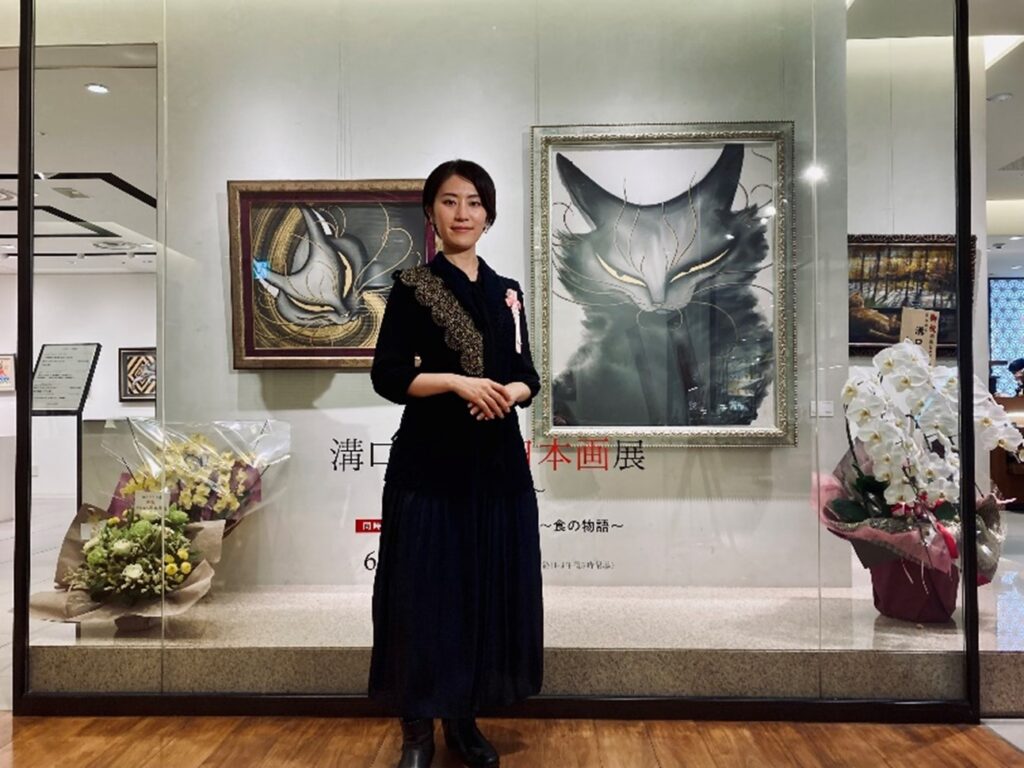
A turning point, the Mitubishi Corporation Art Gate Program
Backtracking to the days when I was roaming the streets of Ginza wondering what to do, I came upon a “Seeking Aspiring Artists” poster at school. The Mitsubishi Corporation was offering scholarships for those seriously aspiring to become an artist.
I knew immediately I wanted to apply, and was later awarded a scholarship. I’m not able to disclose the details of the exam involved, but it was a tremendously difficult process and I spent close to six months fretting over the results. It was probably the most nervous I’d been in my life, and I’m grateful to have been accepted.
I was in my second year of graduate school at the time, and spent one year as a recipient of the scholarship.
Were you asked to submit your artwork in the auction?
Scholarship recipients are given the chance to submit “five pieces of art per auction, four auctions per year”.
I was in the middle of writing my graduate school thesis, and working on two simultaneous paintings; one was an enormous size-100 painting for my classes, the other an even bigger size-150 painting to submit to the Japan Fine Arts Exhibition. The additional 5-pieces of art needed for the Mitsubishi Corporation Art Gate Program auction was a massive undertaking.
To submit 5 paintings, I worked on 10 individual pieces and ultimately chose my best 5 of the batch. Luckily, I was accepted into all four auctions.
Don’t they automatically accept scholarship recipients?
Not at all. You have to go through a selection process, and some get rejected.
Are there public entries who get accepted into the auctions?
Absolutely. The entries are open to the public, resulting in numerous applicants, of which only 50 are selected. Another recipient told me his work wasn’t selected, and I mentioned how challenging it was to have to create five pieces for every auction. At that, he looked at me, flabbergasted, and said “I only submitted one piece!” It was only then that I realized my mistake; I could submit “up to” five pieces per auction! It turns out I had myself to blame for the demanding workload.
What a story!
Submitting 5 pieces of work per auction, for which I painted 10 to choose from, for a total of 4 auctions, helped me to speed up my drawing process. I guess that’s the positive take away from a hectic life in graduate school.
Your pieces fetched the highest bids in all 4 auctions.
Yes, I’m so grateful. There were 53 pieces at the first auction, and one of my pieces was the first “Hinekure Mono” (Sourpuss).
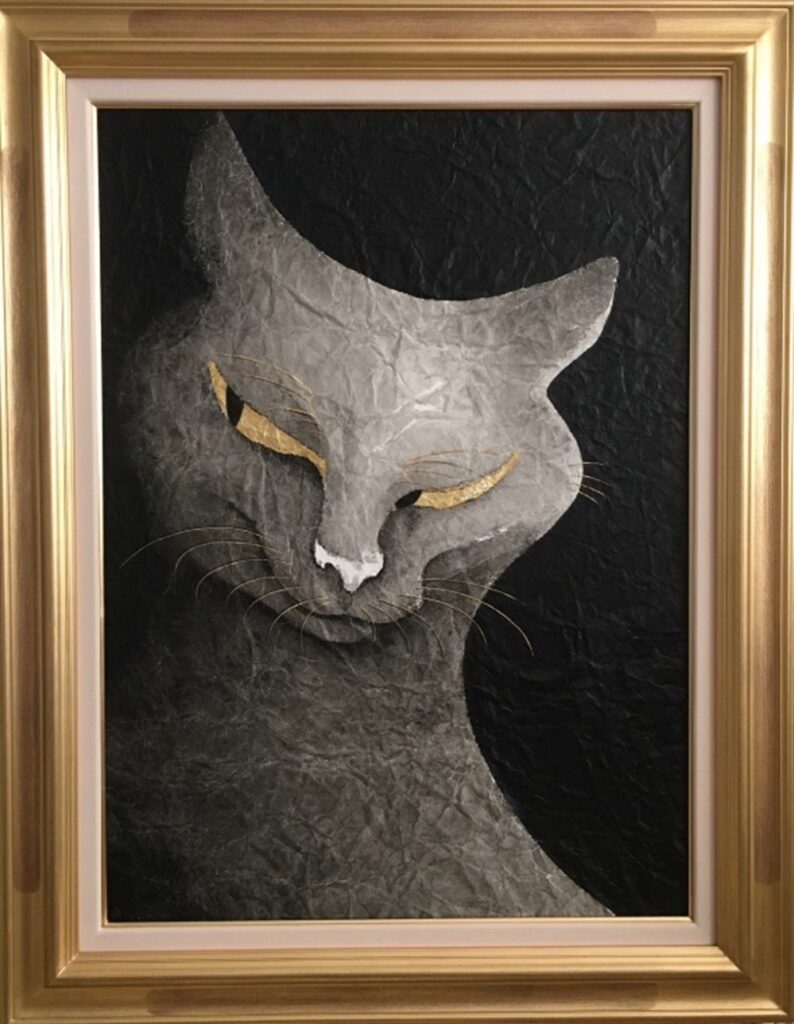
The cat was created for that event!
Yes, the piece was the prototype and the original Hinekure Mono (Sourpuss).
Some lucky person was there, to own such an important piece.
The successful bidder is a wonderful client and cheers me on, even now. They admitted to “not having such an interest in art” back then, that they had just happened to be at the Mitsubishi Corporation building on business, when their eyes met that of my “Hinekure Mono” (Sourpuss). Something in the painting spurred them on to think, “Why not bid on me?”, and the rest is history. They continue to support me and are avid collectors.
My paintings seem to find people that feel destined to buy the paintings, rather than seek cat lovers.
That’s very fortunate.
My artist friends, whom I hold group exhibitions with, sometimes say that I’m “articulate when discussing art”. They may also think I “talk a lot about art”.
I didn’t start out that way, and I was hesitant to talk in front of others at the beginning.
In my everyday life, I used to be holed up in the studio drawing, not needing to discuss art with anyone. At my first auction event, I was so nervous I could barely introduce myself, even if it was just blurting out, “my name is Maria Mizoguchi, student at Joshibi University of Art and Design, majoring in Nihonga painting”.
My public speaking improved over time, getting practice talking about my paintings in front of hundreds of people at the auctions. I constantly tell myself that “I need to make up for what I lack in skill”.
You’re an incredibly hard worker.
The Mitsubishi Corporation Art Gate Program taught me about business etiquette. As a lowly college student, I didn’t know the first thing about sending business emails, and they taught me from zero.
They were very hands on, giving me excellent advice such as “You should revise this sentence” or “The wording sounds a bit off here”, as I was sending out emails. The same goes for how to convey myself on the phone, allowing for smooth communication with art galleries and others. I’m indebted to the Mitsubishi Corporation Art Gate Program for helping me to get to where I am today, and I feel incredibly lucky to have been a part of the program.
Please tell us how you went from submitting your work in the auction, to eventually holding exhibitions at art galleries in major department stores.
One of the collectors who’d been at the auction asked if I would be interested in taking a look at his art gallery. Assuming they were interested in showing my work at their gallery, I went to visit them and showed them my portfolio.
I was surprised when they mentioned that my paintings were more suited for exhibitions at department stores. They got me in touch with a dealer who was in talks about holding exhibitions in a department store gallery, and he introduced me to FukuFukuDo (FFD).
You made your department store debut at the Fukuya Hatchobori department store in Hiroshima, and it was very successful.
I was there for a week during the exhibition. I was very nervous going into it, but it felt like I was meant to be there. I’m grateful for the opportunity, having met people who liked my work and many of them are very supportive of me to this day, coming to visit my exhibitions. I truly appreciate the personal connections I made there.
Making art to last a millennia
Switching track a bit, you’re known to be selective in choosing your art supplies. I would like to learn more about the thinking behind that.
I knew I wanted to become a Nihonga artist when I was a high school sophomore, after having seen Ito Jakuchu’s works. Part of the awe-inspiring sense I felt was due to his pieces having been preserved so well, even after 2-300 years.
I often say that my aspiration is to leave paintings that will last a millennium, and that’s because I want others to feel the same sense of overwhelming wonder towards art 1000 years on. Something I can do now in order to attain this goal is to be intentionally selective in my art supplies, water quality, and to hone my skills and techniques so as to leave behind art that will be appreciated by future generations.

That’s very insightful.
It’s not just about me being fussy about the materials, but the feeling stems from hope that later generations will be able to share and foster a similar sense of awe that I felt.
There are numerous amazing paintings across various art museums, but I sometimes wonder if there might have been more paintings remaining today, if it weren’t for other factors that kept the paintings from being preserved.
As an artist, I feel a sense of duty to preserve art for later generations. Accomplishing skills and knowing what tools and art materials will help me achieve that goal. In Japan, we have pieces that are dated much older than Ito Jakuchu’s works, and we even have Heian-era scrolls. These pieces of art have been preserved well in Japan’s climate and I intend to continue studying its history.
Creating art to encourage those fighting in solitude
I would like to delve a little deeper about the theme of your art.
The painting I’m currently working on is the “Aisubeki Hinekure Neko Series” (The Lovable Sourpuss Series). Yes, I’m drawing a cat, but he’s more than just a cat with a quirky personality. He’s the embodiment of those living proudly and being true to themselves.
I want my paintings to encourage people struggling by themselves; to give courage to people to stick by their beliefs and be willing to march on forward.
I see.
People struggle by themselves at one point or another in life. I hope that my work will encourage and inspire them, and become a friend they feel like they can confide in at the end of the day.
I feel self-conscious to say this, but my collector-patrons often write to tell me that my cats show different facial expressions each time they look at him. Their own mood seems to have an effect on how the paintings look.
Some write to say “I feel like the cat knows me and is rooting for me, I can even tell the painting things I normally can’t say to my family”.
Some of my patrons are cat lovers, but being one isn’t a prerequisite to like my paintings and to feel encouraged.
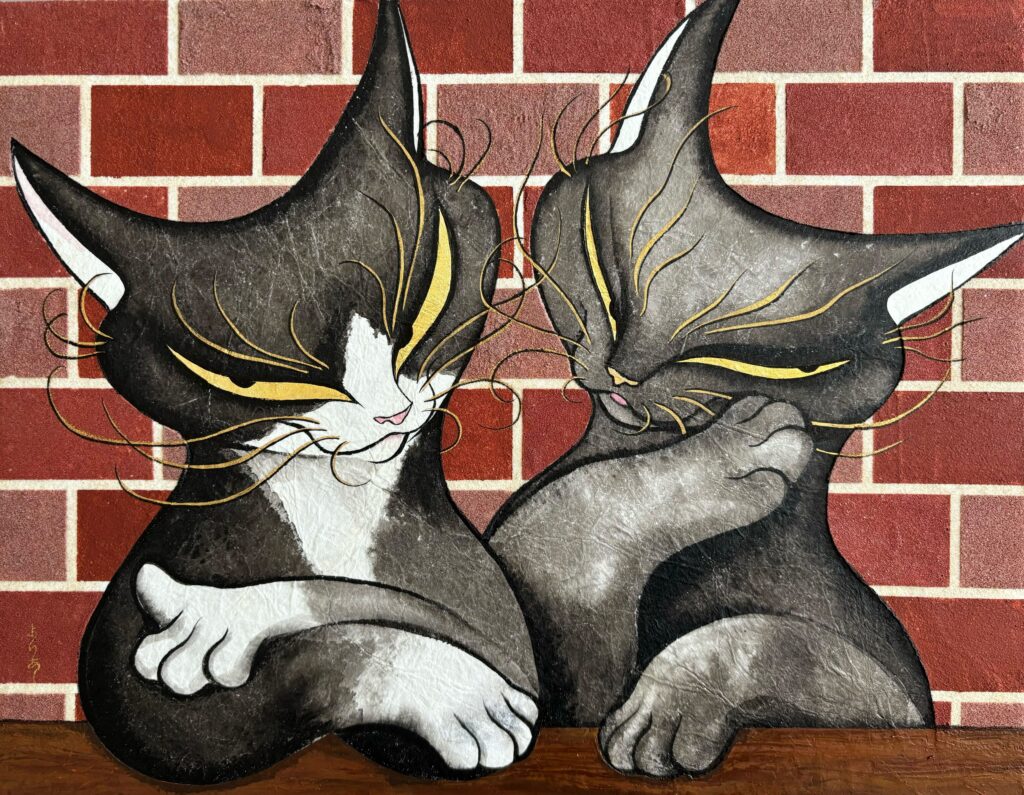
Your dreams are coming true.
I’m very pleased. Drawing loveable characters has a calming effect, but I also hope that my paintings will bring about more compassion in society.
Human beings share similar basic emotions across different periods in time. I’ve heard it said that most people experience all human emotions by the time they’re in their early teens. I want my paintings to reflect these emotions, as its basic theme. The cat is a medium I use, because it’s the best way to express these emotions.
What appears to be a grumpy cat at first glance, is actually a proud, confident being with a strong sense of self. His silent confidence might bring about feelings for some, who wanted to live life that way.
From a human perspective, cats are small animals, but they have their own personalities. They treat us humans as equals and live fearlessly.
On painting stubborn expressions using a cat as a medium
Cats and humans have coexisted forever. I often wonder why, and whether their independent nature is exactly what appeals to us.
I agree.
I’ve had quite a few pets at home, but my cat was the most interesting.
Some say cats are the only animals to have not been fully domesticated, and others say cats are domesticated. There are various theories out there, but the cats’ DNA hasn’t really changed since they came into our lives in the primitive times. Most other animals evolve through domestication; such as wolves into dogs and boars into pigs.
I like to think that cats have a proud and noble streak, being the only animals to have kept their origin while co-existing with humans. It’s quite a feat to stay unchanged regardless of their environment.
Even my Dojo loaches have warmed up to me. The more we poured our love into taking care of the animals, the more they gave back to us, except cats. Cats are fiercely independent, they don’t have a sense of obligation, even if they’re being fed or housed, and eager to stay or to go as they please; “Thanks, I’ll be off now” or “I’ll have my food now”.
Of all the animals to have coexisted with humans for over a millennia, dogs and cats are equally typical as house pets, yet are as opposite from each other as they could be. I don’t know how cats can remain so self-assured, but I find myself not minding that at all.
I know what you mean.
I’ve often wondered why we don’t mind cats being independent. In the same vein, I thought that people would be more understanding of the “sourpuss” emotion being expressed through a painting of a cat than of a person, and perhaps grow to love the emotion as well.
What an interesting idea.
Cats aren’t shy about expressing distrust or arrogance towards us. I think that trying to suppress one’s feelings is akin to denying a part of ourselves. It’s mentally challenging to have to deny a part of oneself, we want to learn to love our whole self. This is what I hope to achieve by using “Hinekure Neko” (Sourpuss) to express such emotions.
Is it an expression of yourself?
In a way, it is. We humans share all basic emotions, so people who are drawn to my paintings might have that in common with me. Having emotions that are difficult to express and to accept are part of what makes us humans, and a vital part of ourselves. When I start creating my paintings, I start by writing down each expression.
On the meaning of writing things down before starting to draw
I try to capture my inspiration and emotion by putting it into words, before making it into a painting. The words then turn into a cat.
How often do you do that?
Every time. I make a number of sketches of the cat, and try to find one that best matches my words. I often use a technique called distortion to express the emotion until the painting is finished.
I had no idea what was entailed in the creative process.
This might be a unique process to me, but I find it important to capture the inspiring moment before it escapes me. While I’m in the process of capturing that emotion, I try not to let anything distract me by focusing on that emotion and not listening to any music, including background music ? although I do allow for music once I’m working on certain monotonous parts of the painting.
When I’m drawing the cat, which is the most important part, I use all my energy to focus. I arrange my space to make it conducive for me to stay focused. Repetitive motions like grinding sumi ink helps me to calm my thoughts and concentrate, before starting the tarashikomi (wet on wet ink) technique. I start by using water on paper and followed by sumi ink to allow for different shading.
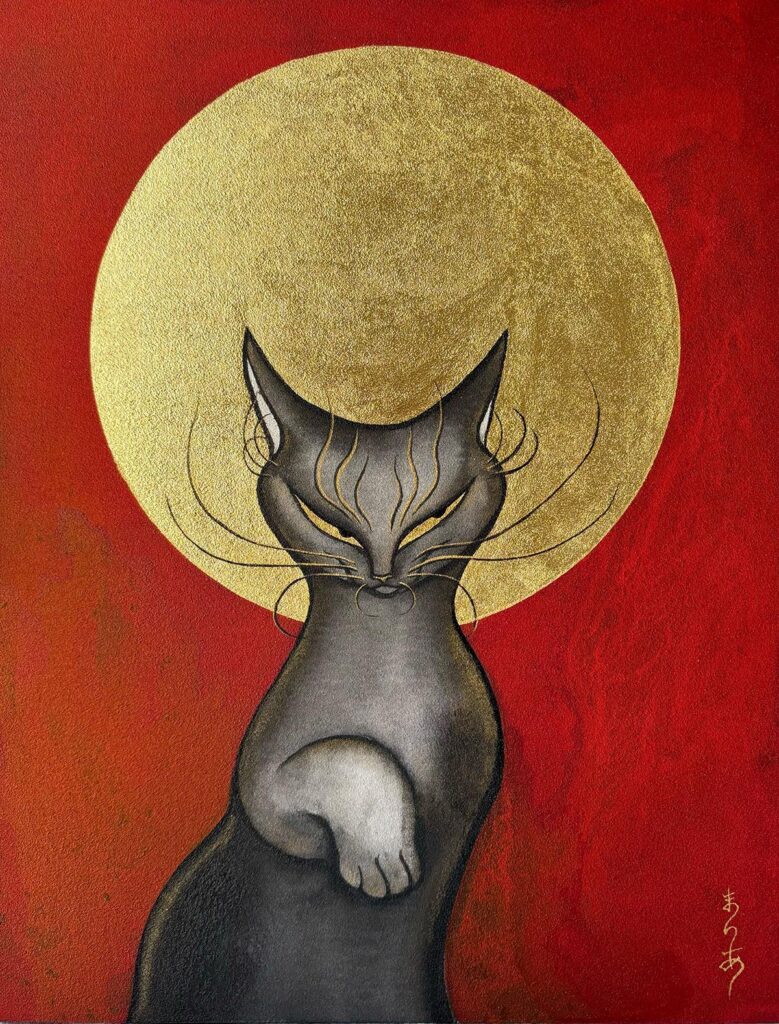
What a fascinating insight into your drawing process.
Knowing what time of the day is best to draw is also very important for me. I usually draw the cat when I can concentrate. The drawing will look different at various times of the day. For instance, at dusk, the background colors will shift as the sun changes its position.
I’m an early riser for both health reasons and to create more time to draw. I finish painting by 6 or 7pm in the evening, though ideally sometime between noon and dusk. On occasion, it may drag on for longer.
I try to get most of my painting done while the sun is up. The colors appear very different under artificial light, especially blue. I make it a rule to finish painting with blue while the sun’s out.
Are these routines ? putting the words down first and not listening to music ? ones you consciously developed through trial and error?
Yes, it was certainly through years of trial and error. I can sense a difference in paintings that I did staying up through the night. I learned to maintain a healthy balance both physically and mentally to be able to draw the way I wanted to. Getting up early, painting while the sun is up, and eating well ? I don’t have any special regimen, but I tend to like soy-based food, such as roasted soy, Ofu (another soy-based product), and Koya-dofu. Honey and Rakkyou (pickled Japanese leek) are also some of my favorites. I had 5 Rakkyou with curry today.
May we go back to talking about your drawing method? I’m curious to know when you started doing that.
I guess from a very early age. You know how sometimes; things happen and your emotions explode? There’s a strong sense of emotion you get when you hear a certain phrase, or when someone says something to you?
When that happens, I think about why that emotion surfaced. Next, I write down the 5W1H (when, where, who, what, why and how). When I retrace my notes from the past, I can see when I experienced the same emotion.
For example, I might be able to go back and remember feeling the same strong emotion when my friend said something to me back in kindergarten. We tend to remember these intense emotions hidden deep in our memory, even if we were very young at the time. Even as adults, these emotional memories can invoke powerful reactions from us at times, sometimes with life-changing consequences. I take stock of and objectively analyze my emotions to find out why it surfaced.
Through this practice, I’ve managed to accept such intense emotions even if I didn’t fully understand them as a child. This is what turns into my art.
On people who have a need for my paintings
Do you mean that you turn your emotions into paintings?
Not quite. If I were to turn my emotions into drawings, almost like venting the emotion, that might be too painful for some to see. So, I try to digest it first, then rephrase it as a more objective theme before starting to paint.
Instead of putting the raw intense emotion directly onto the canvas, I digest and process the emotion and channel it into a more clarified and positive theme. This way, even if the painting appears to represent grouchiness at first glance, it also offers much more, by enveloping and accepting us in its entirety.
I want my paintings to be the impetus to get through difficult issues. I feel certain that there are people who need my paintings.
Will people with difficult issues be able to overcome or perhaps someday be able to laugh at the problem, by analyzing such difficult emotions?
I don’t think you can resolve and overcome it in a single try. I’ve needed to repeat the process over and over. It’s incredibly difficult to repeat this process, but what’s waiting at the end of the process is worth enduring. It’s as if whatever was stuck in my chest gets out and you feel free. It’s embarrassing to admit, but I find myself tearing up at such moments.
When I realize what was bothering me all this time and am able to overcome it, that’s when I know I want to capture the moment and create a painting. Once that happens, I no longer feel sadness or resentment toward the event. I know that it’s resolved within me.
I want my paintings to be a medium for the viewer to see a side of themselves. Using a person as a motif might make the painting too direct and intimidating, but a cat somehow makes that acceptable. They’re lovable and you just can’t hate them. I hope my paintings will offer people a peace of mind and a way to resolve issues.
Cats are precious.
Yes. Despite the sarcastic title, the grouch is no longer offensive when the cat is the protagonist in the painting.

Your painting incorporates traditional patterns and motifs along with your cat.
I conduct research on traditional Japanese elements to use in my paintings. For example, when I interviewed people about Japanese traditional patterns that exist today, I found that these patterns are the outcome of people weaving their thoughts and wishes throughout the times. I sometimes draw upon these patterns and layer it with the themes of my paintings.
The roots of these “traditional patterns” can be traced back to the Silk Road. These patterns came to Japan via the Silk Road, of which the most prosperous was Uzbekistan, land of oases. It was inspired to take a trip, thinking “If I were to visit, I might come across more patterns”, and ended up on a 10-day research trip.
Traveling by sleeper trains in Uzbekistan, I visited local ruins and museums, and was able to see Suzani embroideries in person. Suzani is a type of embroidery often used for brides-to-be, often using pomegranate and chili pepper designs which signify prosperity as well as its usage to ward off evil spirits. At the ruins, seeing the patterns created by various combinations of the blue tiles was inspiring. The discoveries I made during my research trips have become a part of me, and can occasionally be seen emerging in my artwork.

One of the most memorable moments was seeing the full moon. My visit happened to coincide with the full moon, and the view from the vast desert was unforgettable. The moon has a pale blue tint when seen in Japan, due to the high humidity here.
In contrast, in the arid climate in Uzbekistan, the moon is enormous, with a rich golden color. This impressive sight was the first thing I painted as soon as I came back home.
Are you referring to the one with the moon amidst a dark background? That’s the one you painted with the Uzbekistan desert in mind!
Yes, that’s the one.
Listening to your stories, I admire your commitment to delve deeper into an area of interest, whether it be to go on a research trip overseas or spend years studying about techniques in graduate school.
I enjoy exploring things that interest me. When I was young, I was passionate about minerals. I could spend hours in bookstores browsing in the minerals section, and I would have “Science” magazines and journals to read up on the topic. I’m also interested in the medical field and occasionally read magazines in that field.
I continue to be an avid animal lover. Looking back, it seems like I jumped from interest to interest, but I feel that everything that’s fascinated me has led a path to my artwork. From selecting and grinding “minerals” for my mineral pigments, to my love of “animals” being the theme of my paintings, it’s all intertwined.
I can see parallels between your painting and your life journey. I sincerely look forward to seeing more of your art in the future. Thank you for your time today.
(Interviewer, FFD editorial team)
A day in the life of Maria Mizoguchi
We would love to hear your daily routine.
Early morning
I wake up very early, and clean my room. As I prepare to paint, I spray the room with mist to prevent the air from getting too dry.
7 AM
Breakfast
7:30 AM
I calm my thoughts by grinding sumi ink. I draw cats first thing in the morning.
8 AM
If there’s time, I write down my thoughts for the day and analyze the emotions. I start working on another painting while waiting for the first one to dry.
Noon
Lunch.
I sometimes forget to eat lunch if I’m really focused and working alone, and on occasion I forget the time entirely and find it already dark outside. The paint colors start changing once the sun goes down, so I try to paint as much as I can while there’s still sunlight. I try to finish painting by 6pm.
After dinner
Every night, I spend time writing and making illustrations to post on social media.
What do you do to take a break for a change of pace?
I take walks daily whenever the mood strikes me, morning, noon or evening. I like to stop by art supply shops or home improvement stores and geek out on specialty materials;
“I wonder how I can use this in my art”, or
“I wonder if I can use this sturdy-looking paint brush for backgrounds or for glue”.
I can spend a long time just thinking about these things, and sometimes, I come back with one or two things.
I’ve unexpectedly discovered very useful items to help with creating my paintings and these stores have become my go-to stores.

But my favorite is stopping by my local art supply shop. I could spend hours there. I enjoy looking at sections that’s outside my field, such as in the oil, acrylic or watercolor section. I sometimes visit the pottery corner, silkscreen printing sections or aisles where they sell T-shirt making materials. I like to think that knowledge might come in handy someday.
Among other painting materials, I’m also fond of pastels. My mentor in college mentioned how helpful it is to use pastels when doing preliminary drawings for Nihonga.
It turns out the mineral pigments used in Nihonga and pastels have a similar consistency. The colors of the pigments are similar as well. These are types of things I’m on the lookout for when I browse art shops.
Oh, I recently came across a crayon that caught my attention. It’s about the size of a carrot.
Do you have a workout regimen to help life as an artist?
You need to be physically fit to paint. I thought about getting my body back in shape and recently started doing Pilates.
This is a movement exercise created by Mr. Pilates in order to help him train without putting extra strain on his frail body, and is often used as a rehabilitation tool with athletes.
I hurt my legs in 2020, and couldn’t walk without the aid of a cane for a few months. I resolved to train my core muscles and started going to Pilates lessons. Exercising is not my forte, but Pilates is something that one can do at their own pace and it’s been good for me. I think artists would benefit from physical training.
The process of making art, by Maria Mizoguchi
- Deciding on a theme
Verbalize and organize your emotions and write a theme.
Use research materials and information you gathered to base your foundation on. - Gathering art materials
Gather materials and supplies from all over your home and select ones that you will use.

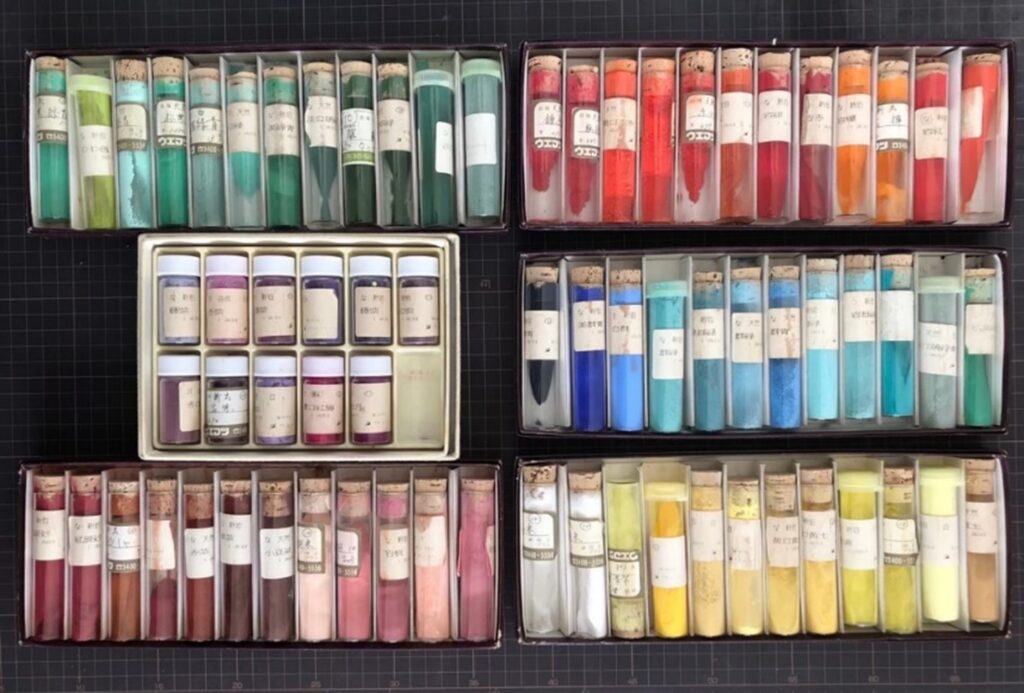
- Preparing the panel
Apply two coats of rabbit glue to prevent burning, then a thin layer of washi. This is to prevent the tree tar seeping out from the wooden panel from damaging the washi. This preparation step is very important to reduce damage later on. - Washi processing
When creating with the “Momi-Gami”, we first knead the paper and crumple it up. This is followed by “Urauchi” (backing), in which a strong, thin layer of washi is applied to the back for reinforcement.
To make the backing,
(1) First make the glue by cooking it in a pot, constantly stirring so as not to let it burn.
(2) Put the glue through a strainer, then use water to dilute it
(3) Use the glue to attach a thin layer of washi to the back of the washi paper
The Momi-gami step must be done before the backing, because the reverse sometimes results in the paper peeling off.
Remember to blot the washi again after the glue dries.



- Building the panel
Complete making the panel by gluing washi paper to the panel using starch glue.

- Drawing
When drawing, I start from the bottom layer. In my case, the cat is often the bottom layer. Once I finish painting the cat, I draw the background to complete the painting.





Description of work

-Inviting you all to a bright new life –
(FFD editorial team)
Artist Maria Mizoguchi bio, awards, and exhibitions
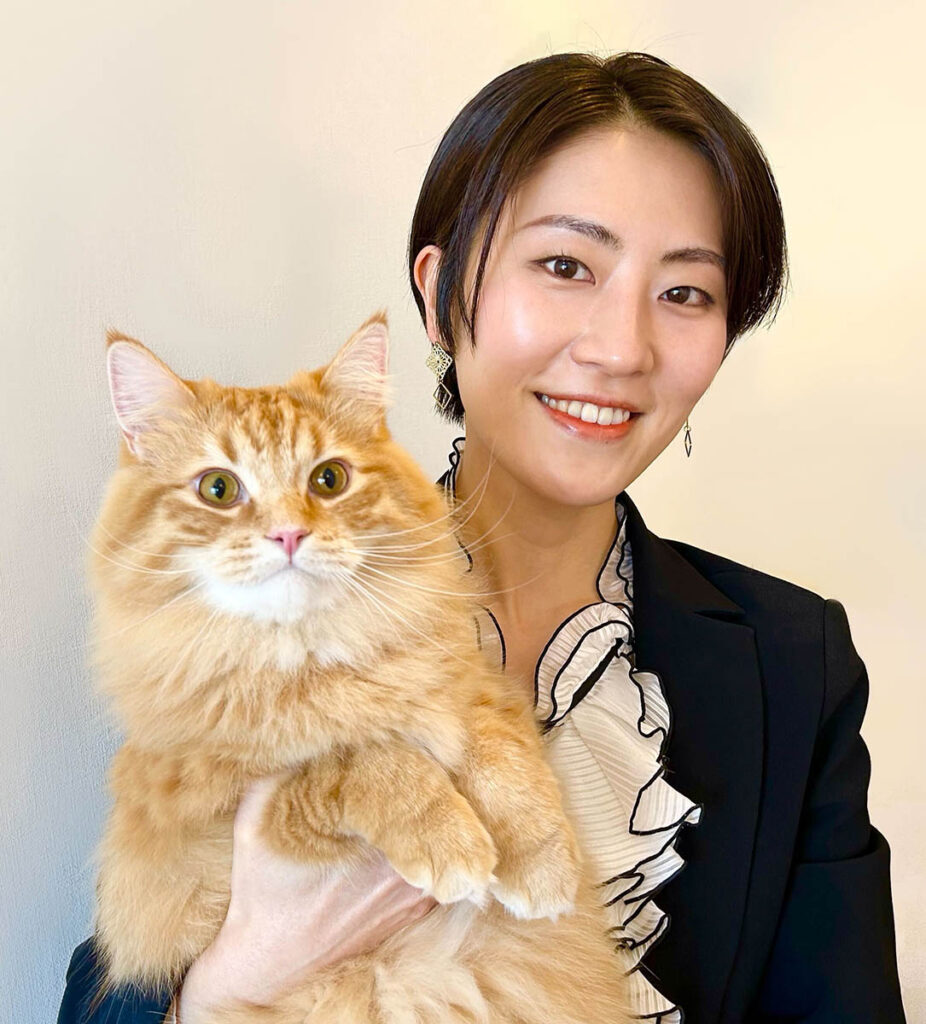
Maria Mizoguchi, Nihonga Artist
1992 Born in Setagaya, Tokyo
2015 Graduated from Joshibi University of Arts and Design, with a major in Nihonga
2016 Mitsubishi Corporation Art Gate Program Scholarship Recipient
2017 Doctoral Candidate in Nihonga Research Field, Joshibi University, Graduate School of Arts and Design
2016
● The 33rd Mitsubishi Corporation Art Gate Program, Honorable Mention, Purchase of Works
2017
● The 1st SinNissyunten Exhibition, Honorable Mention (exhibited at the Tokyo Metropolitan Art Museum)
● The 34th Mitsubishi Corporation Art Gate Program, Honorable Mention, Purchase of Works
● The 35th Mitsubishi Corporation Art Gate Program, Honorable Mention, Purchase of Works
● The 36th Mitsubishi Corporation Art Gate Program, Honorable Mention, Purchase of Works
● The 4th Reorganized New Japan Art Exhibition “Nitten”, Honrable Mention (The National Art Center Tokyo)
2018
● The 2nd SinNissyunten Exhibition, Honorable Mention (Tokyo Metropolitan Art Museum)
2020
● WINE PROJECT 2020 The Republic of San Marino Winery “Peace Wine” wine label artist
2017
● “Mitsubishi Corporation Art Gate Program ? A Gateway to Success for Young Artists”, Fuji Evening Edition, special feature page
● “Exhibition marking the 90th anniversary of the artist Yorozu Tetsugoro’s death; ‘My Painting’ selected by three up-and-coming female painters, Tokyo Shinbun
● “The 5th MVW ~Kouhaku Bijutsu Gassen~, Mainichi Shinbun
2018
● “Artist’s drawing (My Reusable Bag)”, Saitama Shinbun
● “My Illustration”, Tokyo Shinbun
2019
● “Nihonga Artist recommended by Art dealers and Nihonga Artist recommended by Major Department store Art Buyers”, Art Collectors, January edition
● “Eleven Girls Art Collection (newest member)”, Hiroshima TV, aired January 31st
● “11 Female Artists Living by Art”, TSS Shin-Hiroshima TV, aired February 26th
● “Aisubeki Hinekure Neko” (The Lovable Sourpuss) Exhibition, Tokyo Shinbun
● “Neko Kaigi” (Council of Cats), Hyakubei No.51, Bijutsuya
● “The art gallery choice of up-and-coming artists”, May edition, Bijutsu no Mado
● “Introducing 30 Nihonga paintings portraying cats’ emotions”, Tokyo Shinbun
2020
● “Editors’ picks for top Nihonga artists”, Art Collectors, January edition
● “Exhibition of 11 up-and-coming female artists” Hanshin Umeda Main Building, Sankei Shinbun
● “ONBEAT picks for notable young artists”, Art magazine ONBEAT Vol. 13
2021
● “10th Anniversary Grand EGC Exhibition”, Art Collectors, March edition
● Hirosihma City Cultural Foundation publication, Cultural Information Magazine “To You”, November edition
● “Maria Mizoguchi Nihonga Exhibition ~A Connected World~”, Tokyo Shinbun
● “Murals using Protecton”, Nippon Paint Company web article
● Mural completion interview “TV school”, Hiroshima TV, aired October 21st
● “The peaceful first mural”, Chugoku Shinbun
2022
● Art book “Composing variations”
● “The 1st Next Generations” series, Chugoku Shinbun
● “Nihonga you feel close to”, Osaka Nichinichi Shinbun
● “Exhibition Descriptions”, Art Collectors June edition
● “Exhibition Descriptions”, Monthly Art Magazine June edition
● “Maria Mizoguchi Nihonga Exhibition ~Journey of the Soul~”, Tokyo Shinbun
● “A new breeze of Art: A Colorful art Exhibition of 11 female artists”, Yomiuri Shinbun
2023
● “Duo exhibition ~Cat Festival~”, Mainichi Shinbun
● “Duo exhibition ~Cat Festival~”, Osaka Nichinichi Shinbun
● “Ginza Mitsukoshi Exhibition Description”, Monthly Art Magazine June edition
● “On buying art with monthly Art Plus magazine”, Monthly Art magazine August edition
● “Maria Mizoguchi Nihonga Exhibition ~Proud Cats~”, Tokyo Shinbun
● “Maria Mizoguchi Nihonga Exhibition”, Yomiuri Shinbun
● “On buying art with monthly Art Plus magazine”, Monthly Art magazine October edition
2017
● MVW Exhibition, Fukuya Hatchobori Main Building, Hiroshima
2018
● Gold and Silver Leaf Exhibition, Isetan Urawa Store, Saitama
● “Momoka Exhibition”, Fukuya Hatchobori Main Building, Hiroshima
● Duo Exhibition “On a moonlit night”, Isetan Urawa store, Saitama
● EGC Exhibition, Hanshin Umeda Main Building, Osaka
● Shanghai Art Fair 2018, Shanghai
2019
● EGC Exhibition Fukuya Hatchobori Main Building (Hiroshima)
● Solo Exhibition “Maria Mizoguchi Nihonga Special Feature”, Isetan Shinjuku Main Building, Tokyo
● Solo Exhibition “Maria Mizoguchi Nihonga Exhibition ~Sourpuss Cat~” Isetan Urawa store, Saitama
● “ART GAIA JONANJIMA Modern Art Exhibition“, Tokyo
● EGC Exhibition, Hanshin Umeda Main Building, Osaka
● Osaka Art Festival, Hanshin Umeda Main Building, Osaka
2020
● “FOUR ELEMENTS”, Isetan Shinjuku Main Building, Tokyo
● Art Safari Park, Isetan Shinjuku Main Building, Tokyo
● Solo Exhibition “Maria Mizoguchi Nihonga Exhibition ~Sourpuss Cat~”, Isetan Urawa Store, Saitama
● EGC Exhibition, Hanshin Umeda Main Building, Osaka
● “Rewa Zoological Exhibition”, Fukuya Hatchobori Main Building, Hiroshima
2021
● “Grand EGC Exhibition”, Hilltopia Art Square, Tokyo
● “Mural Production” Higashi-ku Citizens Cultural Center, Children’s Room, Hiroshima
● Solo Exhibition “Maria Mizoguchi Nihonga Exhibition”, Isetan Urawa Store, Saitama
● Duo Exhibition “Animal Paintings from the Golden Country”, Fukuya Hatchobori Main Building, Hiroshima
● Trio Exhibition “EGC Select Exhibition”, Hanshin Umeda Main Building, Osaka
● “NEXT GENERATIONS Exhibition”, Fukuya Hiroshima Station store, Hiroshima
2022
● Solo Exhibition “Maria Mizoguchi Nihonga Exhibition ~A Connected World~”, Hanshin Umeda Main Building, Osaka
● Solo Exhibition “Maria Mizoguchi Nihonga Exhibition ~Journey of the Soul~”, Ginza Mitsukoshi Main Building, Tokyo
● “EGC Exhibition”, Fukuya Hatchobori Main Building, Hiroshima
● “EGC Exhibition”, Hanshin Umeda Main Building, Osaka
● “Composing variations” Traveling Exhibition, Tokyo, Kyoto, Fukuoka, Sendai
● “The 10th Annual EGC Exhibition”, Fukuya Hatchobori Main Building, Hiroshima
● “The 10th Grand EGC Exhibition”, Hanshin Umeda Main Building, Osaka
● Donation for Mainichi Shinbun Charity Auction
2023
● “CAT PERSON” Tokyo Midtown Galleria Roppongi ISETAN SALONE, Tokyo, February
● “Healing Jizo in HANSHIN”, Hanshin Umeda Main Building, Osaka, March
● Duo Exhibition “Cat Festival”, Hanshin Umeda Main Building, Osaka, April
● “Composing variations”, Hanshin Umeda Main Building, Osaka, June
● Solo Exhibition “Maria Mizoguchi Nihonga Exhibition ~Cat Festival~”, Ginza Mitsukoshi Main Building, Tokyo, June
● October Edition Monthly Art Plus Online Magazine, July
● “ONBEAT Art Show HIROSHIMA”, Mitsukoshi Hiroshima, Hiroshima, August
● ONBEAT Art Show, Hankyu Hakata, Fukuoka, September
● Solo Exhibition “Maria Mizoguchi Nihonga Exhibition ~Proud Cats~”, Isetan Urawa Store, Saitama, September
● “ONBEAT Art Show”, Ginza Mitsukoshi Main Store, Tokyo, November
● Solo Exhibition “Maria Mizoguchi Nihonga Exhibition ~Proud Cats~”, Fukuya Hatchobori Main Building, Hiroshima, November
● Mainichi Shinbun Charity Auction, December
2024
● Solo Exhibition “Maria Mizoguchi Nihonga Exhibition ~Proud Cats~”, Hanshin Umeda Main Building, February
Maria Mizoguchi, Artist website
https://mizoguchi-maria.jimdofree.com/
Instagram
https://www.instagram.com/maria_mzgchi/
YouTube
https://m.youtube.com/channel/UCxDZFkE88fMar-P-0Db5GsQ
Details of Maria Mizoguchi’s Exhibition
Coming soon…
